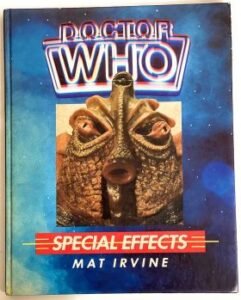Doctor Who: Special Effects by Mat Irvine (book review).
I came across this book, ‘Doctor Who: Special Effects’ by Mat Irvine, on e-auction recently and realised I’d never come across his first book. I actually met Mat Irvine in a late 1970s Comicon when he was in early prepping and delighting the few people there by showing Boris the spider on the floor.
A few years ago, I received some material from a publisher that was intended for him and forwarded it to him. I doubt if he’ll remember me, but should he read this review, at least there is a connection because I like his work and expertise. Oddly, I have also reviewed his ‘VFX’ and ‘Model Building Manual’ for Haynes books, just never this one. He’s very productive.
This book is loaded with his photographs up to this time, not only from ‘Doctor Who’ but also other series he worked on, like ‘Blake’s 7’ and ‘The Tripods’. Irvine gives a brief history of the BBC Special Effects Department, which in 1963, ‘Doctor Who’ became its biggest customer. I looked up, and he joined in 1969, although it doesn’t detail his own history rising up through the ranks.
Obviously, more of this book covers his work on ‘Doctor Who’, explaining the production at the time and how work is done based on time and money and ensuring how many props are needed. In many respects, apart from CGI, things are pretty much the same today. For the record, the chief stories are ‘Warrior’s Gate’ and ‘The Stones Of Blood’, so Irvine can explain specifics for two-thirds of the book. The rest is devoted to particular aspects of the show. Little things like the TARDIS, Daleks and K-9, which he rebuilt and sorted out its frequency problems with TV cameras.
What is intriguing is his view of the future of TV at the time. As if we’d ever have flat-screen TVs as he looked in from 1986. If anything, Irvine was very prophetic, including high-resolution television so far back. However, he worked in TV and could see where the advances were going to go, irrespective of whether the public would expect it. He was also quite right that improved TV reception meant more detail on the model work would be needed.
If you’re interested in how the effects were made in the classic ‘Doctor Who’ age, then this book is a must. It’s not a heavy read but is still detailed in how things were done and evolved. Without the work of Irvine and other members of the Special Effects Unit back then on a tight budget, we wouldn’t have had the basis of the ‘Doctor Who’ TV series we have today.
GF Willmetts
October 2025
(pub: Beaver Books, 1986. 96 page illustrated indexed softcover. Price: varies. ISBN: 0-09-942630-7).


